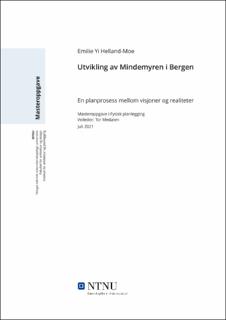| dc.contributor.advisor | Medalen, Tor | |
| dc.contributor.author | Helland-Moe, Emilie Yi | |
| dc.date.accessioned | 2021-10-26T17:19:43Z | |
| dc.date.available | 2021-10-26T17:19:43Z | |
| dc.date.issued | 2021 | |
| dc.identifier | no.ntnu:inspera:85482393:15495558 | |
| dc.identifier.uri | https://hdl.handle.net/11250/2825810 | |
| dc.description.abstract | Denne oppgavens hensikt er å undersøke hvordan planverktøyet har fungert fra visjoner i overordnede planer til detaljreguleringsplaner på Mindemyren i Bergen. Planområdet er lokalisert sentralt i Bergensdalen, og består i dag av arealkrevende næringsvirksomhet. Som en del av kommunens strategi for å utvikle byen i tråd med nasjonale føringer om en bærekraftig byutvikling, har de i overordnede plandokumenter pekt ut Mindemyren som et område med et stort utbyggingspotensiale.
Gjennom områdereguleringen fra 2014, har kommunen lagt til grunn en visjon om at Mindemyren skal utvikles til en attraktiv, kompakt og urban bydel, i samsvar med kommunens visjon. I dag er dette i ferd med å bli realisert gjennom utbygging av bybanen, detaljreguleringer og byggesaker. Området er omfattende og består av 25 delfelt, med en rekke aktører og rammeverk som skal koordineres gjennom en markedsbasert byutvikling. I praksis kan det være utfordrende å både gjennomføre planprosesser og å ivareta en ønsket utvikling i henhold til visjon og vedtatte mål.
For å besvare oppgavens problemstilling har to kvalitative metoder blitt anvendt. Dokumentanalysen belyser hvilke planer og rammeverk som ligger til grunn for utviklingen på Mindemyren. Dybdeintervjuene gir innsikt i hva som ble lagt til grunn da de kommunale plandokumentene ble utarbeidet, og hvordan de private aktørene har opplevd å jobbe innenfor de gitte rammene. Problemstillingen blir deretter knyttet opp mot aktuell teori, og drøftet ut fra oppgavens tre forskningsspørsmål.
Oppgavens funn viser at prosessen på Mindemyren ikke har fungert optimalt. Utfordringene har blitt utløst av større endringer i planområdet, både i form av den fastlagte visjonen, økt planaktivitet og utbyggingen av bybanen. I tillegg er det spesielt to forhold som har forsterket disse utfordringene. For det første har endringer i visjonen for området i kombinasjon med lite ressurser hos kommunen, ført til en uoversiktlig og uforutsigbar planprosess for alle parter. For det andre har ikke kommunen klart å organisere seg tilstrekkelig etter behov, før sent i prosessen. Samlet har dette ført til en konflikt mellom utbyggernes ønske om effektivitet, og saksbehandlernes ønske om å fastsette visjonen i overordnede føringer. Til tross for at det har vært en utfordrende planprosess, viser funnene til en positiv utvikling, hvor kommunen har klart å omstille seg, og blitt mer aktiv i rollen som forvalter av planområdet. | |
| dc.description.abstract | This thesis examines how planning tools have worked from visions in overall plans to detailed zoning plans for Mindemyren in Bergen. The planning area is centrally located in Bergensdalen and currently consists of area-intensive business activities. As a part of the municipality's strategy to develop the city in line with national guidelines of a sustainable urban development, they have appointed Mindemyren as an area with great development potential in their overall planning documents.
Through the area zoning plan from 2014, the municipality has set a basis for a vision that Mindemyren will be developed into an attractive, compact and urban district, in accordance with the municipality's vision. Today, this is realized through physical development of the city light rail, detailed zoning plans and building application. The area is extensive and consists of 25 subfields, a number of actors and frameworks that will be coordinated through a market-oriented urban development. This can in reality make it challenging to both implement and achieve a desired development in accordance with the vision and adoptet goals. In practice, it can be challenging to both implement planning processes and maintain a desired development in accordance with the vision and adopted goals.
To answer the problem of the thesis, two qualitative methods have been applied. The document analysis shows which plans and frameworks that form the basis for the development at Mindemyren. The interviews provide an insight into how the municipal planning documents were formed, and how the private actors have experienced working with the given framework. The problem is then linked to current theory, and discussed on the basis of the thesis' three research questions.
The findings of the thesis shows that the process at Mindemyren has not worked optimally. The challenges have been initiated by major changes in the planning area, both in the form of the established vision, increased planning activity and the physical development of the city light rail. In addition, there are two factors in particular that have exacerbated these challenges. First, changes in the vision for the area in combination with lack of resources in the municipality, have led to a confusing and unpredictable planning process for all parties. Secondly, the municipality has not been able to organize itself sufficiently as needed, until late in the process. Overall, this has led to a conflict between the developers' desire for efficiency and the municipality's desire to establish the vision in the overall guidelines. Despite it being a challenging process, the findings point to a positive change, where the municipality has managed to adapt, and become more active in the role of administrator of the planning area. | |
| dc.language | nob | |
| dc.publisher | NTNU | |
| dc.title | Utvikling av Mindemyren i Bergen - en planprosess mellom visjoner og realiteter | |
| dc.type | Master thesis | |
